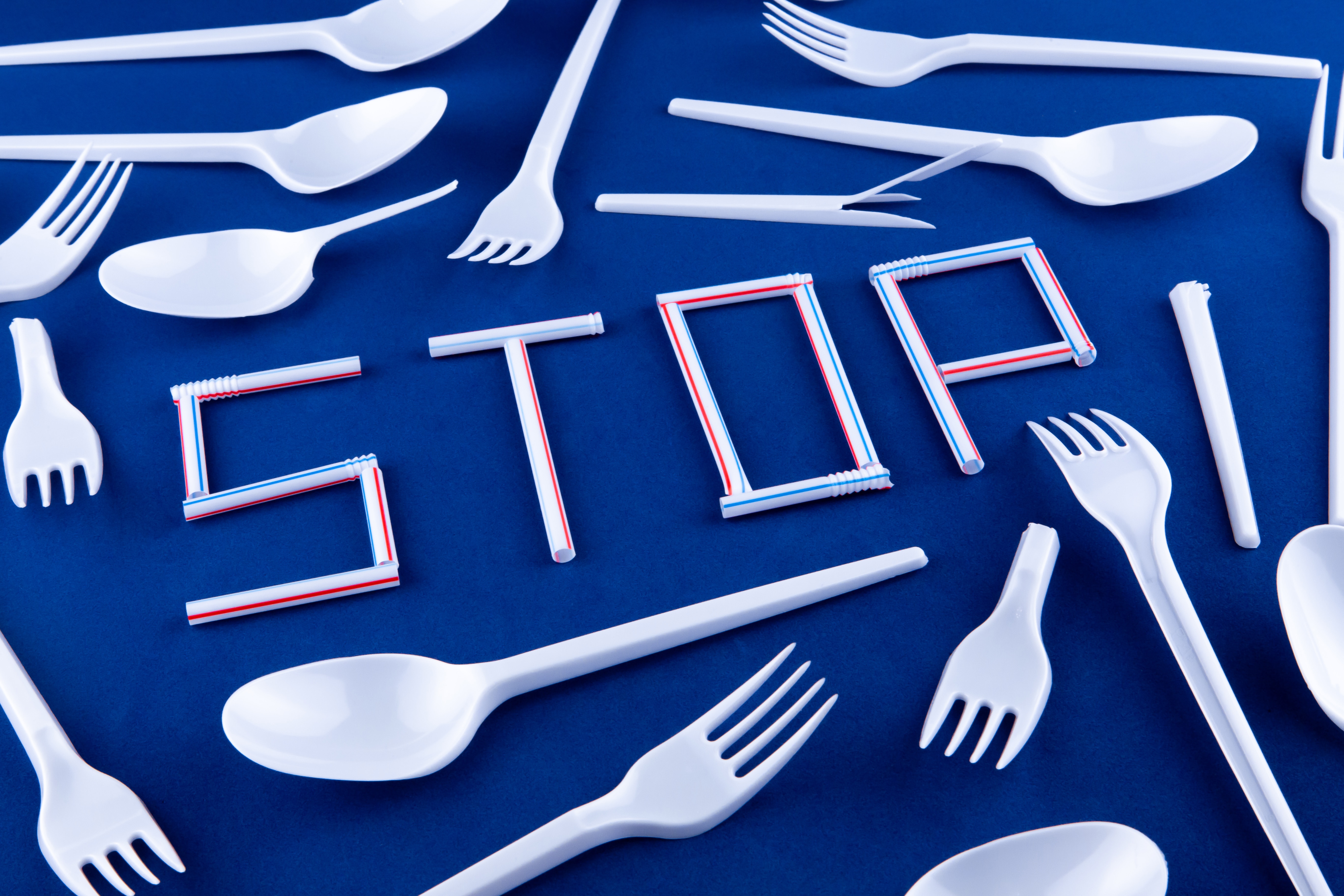There has been a lot of talk recently around single-use plastics. In June of 2019, the Canadian Federal government raised eyebrows over its intention to eventually ban single-use plastics. In British Columbia, the Provincial government is engaging citizens on its intention to do away with single-use plastics through the CleanBC Program, using jarring graphics to help highlight the concerns that plastics pose to marine life. Closer to home, the City of Vancouver has used its unique Vancouver Charter to introduce an aggressive phasing out of single-use items, including plastic compostables (we’ll get to those in a moment).
Meanwhile, industry is challenging these moves by suing government initiatives such as the plastic bag ban in Victoria, which was recently dealt a major upset in federal court. Despite this, we are becoming increasingly aware of the connection between plastic pollution and climate change, beyond the obvious environmental concerns. Non-governmental organizations such as Ocean Ambassadors are actively addressing these issues through creative methods of education and awareness-building. Retailers are responding by discouraging plastic bag use by charging for them – a step BCIT retailers took last year. While this switch has been seen by some as a price-gouge to recoup costs on a previously free item, there’s no doubt that reusable bag use has been on the uptick.
In the coming weeks, food service outlets operated by BCIT and the BCITSA will be entirely eliminating plastic cutlery. There will be a switch to plant-fibre based cutlery, with charges coming into effect by mid-March. This will be a significant change, and the decision was not taken lightly. The overall intention is to support people to switch from a reliance on single-use items, towards reusable implements. Customers are encouraged to bring their own cutlery and will be able to purchase reusable cutlery kits on campus.
“…food service outlets operated by BCIT and the BCITSA will be entirely eliminating plastic cutlery.”
Utilizing the most current information available, this article is intended to provide context to this switch, and a jumping point for additional resources.
But aren’t plastics recyclable?
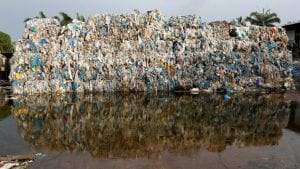
The recycling market has shifted considerably ever since the Chinese government introduced the National Sword policy in 2017. There has been plenty written on this topic from Yale Environment to BCIT’s Link Magazine, but to understand this issue, we must go further back in time. For the past few decades as the prices of overseas shipping plummeted and the Chinese manufacturing sector began to balloon, the demand for resources began to outstrip the pace of virgin material production. During this same time, many communities began ramping up their recycling programs. To make collection even simpler in some communities, single-stream recycling was introduced – a catch-all curbside bin for anything with a recycling symbol. What presented as a virtuous cycle to western consumption was in actuality a slow-moving environmental catastrophe. People began to throw in everything with a recycling symbol, and without a recycling symbol. Tales of diapers, Fisher-Price kitchen sets, hoses, tricycles and every other variety of consumer good are not uncommon – so much that they’ve bred a name – Wishcycling.
But, eventually the system caught up with itself. In 2017, after realizing that this system was resulting in a considerable amount of received materials to be burned or placed in poorly engineered landfills, China’s National Sword policy came into effect. Previously the largest importer of recyclables, the system did not completely ban all imports: it simply imposed a higher quality of sorted materials destined for recycling. However, the net effect was a massive rejection rate in all recycling categories… so wholesalers went to other less discerning markets…
But even those locations had enough. In the case of the Philippine-Canada waste dispute, the Philippine government of Rodrigo Duterte threatened war in retaliation for 69 shipping containers that were left languishing with rotting plastics mixed with garbage – all a likely consequence of wishcycling.
Have you subscribed? Sign-up to receive the latest news on BCIT.
So, why recycle?
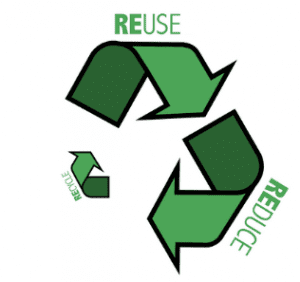
In waste reduction circles, recycling has long been regarded as the last choice of the three R’s – Reduce, Reuse, Recycle. In the principal of a circular economy, given the amount of invested energy and resources, we should use manufactured products as effectively as possible, and where possible, reformulate those products into other useful products in order to reduce dependence on resource extraction, which further degrades natural ecosystems. In the ideal world, every product could be completely disassembled into a unique resource that could efficiently be placed back into a manufacturing system. A local example of this principle is in the locally-based company Unbuilders, with the motto, “We don’t demolish your home, we unbuild it,” who deconstruct homes into resellable products.
Assuming that we as a society decide that recycling is preferential to the extraction of virgin materials, a few things have to happen. A recycling system requires basic sorting of items. Metro Vancouver has done a reasonable job by requiring residents to sort their recyclables into various streams. Some years ago, the region won some recognition for this system. However, it is a tricky challenge for the regional district and municipalities to require their residents to perform what is essentially an industrially-oriented activity. Each week, residents are required to follow the myriad instructions on how to specifically sort recyclables to ensure that they are received on the other end of a system which could potentially get clogged if insufficient sorting previously took place. This system relies on the same self-sufficiency as a parts installer in a car manufacturing plant – if components are not carefully installed in the early stages, successive installers cannot properly complete their tasks. In contrast, lawmakers elsewhere in North America have reduced their dependency on residents’ abilities to sort with some municipalities employing single-entry Materials Recovery Facilities (MRF). However, in a bid to make things simpler for these residents, MRF facilities in those areas tend to experience much higher levels of contamination of small things like dirty containers, in addition to bigger wishcycling offenders due to the reduced level of public education – why go to the trouble with public education around the nuances of acceptable materials if the objective is to make things simple? Speaking of which, why are there so many nuanced differences between municipalities and businesses? Because municipal regulations tend to be guided by the actual operational capacity of recycling companies.

One notable myth is the thought that municipal governments are in charge of the entire recycling system, when in reality, our municipalities are simply courier agencies of waste. Our tax dollars, or more specifically our various property taxes and service fees, pay for municipally-sponsored hauling trucks (city staff or privatized service depending on your municipality) to pick up our waste from our places of residence and drop them off at either prearranged landfill transfer stations, or recycling sorting facilities, who then pass on a fee to the municipal hauler. Commercial premises and institutional sites like BCIT campuses operate under a completely separate system, with varying obligations to follow local government requirements on waste reduction. In many cases, an organization’s waste hauling habits are largely based on their corporate values – at BCIT, because zero waste has been identified as a priority, the Facilities & Campus Development and Corporate Services teams have invested resources into collecting multiple waste streams and identifying appropriate companies to handle those streams.

The largest myth of all however, is the notion that recycling is the salvation to our consumption habits. The reality is that recycling has a limited market that is dependent on the careful interconnection between global systems, and these all require thoughtful consideration of how we recycle. In principle, if residents and organizations are acutely aware of their local recycling regulations and ensure that actual recyclables are correctly sorted, the system is capable of re-manufacturing end of life materials into new products. However, there are a lot of implied ‘ifs’ in that scenario. And, in light of the current crisis with China, we are aware that many low-grade recyclables and system contaminants are currently being incinerated in the region’s waste-to-energy plant, at least until the sector recovers.
Towards Zero Waste
At BCIT and many other organizations with food service operations, single-use forks, knives, and straws have been as freely available as toilet paper. Three meals per day? – that’ll be three sets of cutlery per day. And, with each spoon, that’ll be 2.5 grams of plastic that was produced in factory from petroleum, and combined in a box with other forks if they weren’t individually sealed in a plastic film bag, and packaged with other boxes into larger boxes then placed onto a pallet, shrink-wrapped to prevent tipping, then shipped by truck to an intermediary supplier, who then may split the shipment and re-sort the boxes, then ship onward to the food service establishment, who then discards all of the packaging and places them neatly in a bin for a customer to use for approximately 15 to 20 minutes depending on how leisurely they finish their meal…
…then toss the implement in the garbage can whereupon it is bagged then placed into a dumpster, whereon a waste hauler forks the dumpster’s contents into its cargo hold until it arrives at a transfer stations whereupon the waste is recollected into trailers then taken to a landfill site where it will be dumped into neat piles, then buried by a layer of dirt at the end of the work day to prevent being picked up by the wind or eaten by wildlife, whereupon it will sit entombed in its waste cell for nearly a thousand years, disguised as a mountain, and with enough luck, will not liquefy into a toxic sludge in several generations and contaminate the water table.
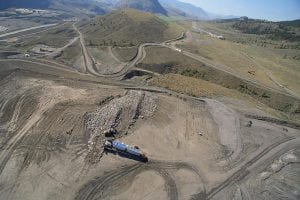
As an alternative to plastic forks and knives, BCIT and BCITSA food services operations have identified plant-fibre based cutlery as a disposable alternative. Since plastic cutlery is by nature soiled at the end of its life, and cleaning is likely not a viable option in most cost-sensitive food service environments, recycling is not a possibility, if the implement is indeed otherwise recyclable within the jurisdiction. However, plant-fibre based cutlery presents a technological possibility that is designed around ease of use in these types of quick service environments. With plant-fibre based cutlery, the entire contents of a food tray, including non-plastic film lined paper products, the cutlery and food itself can be tossed into a compost bin. This scenario is identical to the one above, except that petroleum is not required in the production, and instead of storage in a landfill cell, the cutlery will decay into compost and then could be used as a soil conditioner for crops or landscaping.
What about compostable plastics (bioplastics)?
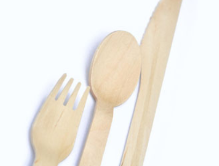
There has been a lot of recent discussion around a relatively new breakthrough in plastics technology. Promising to resemble familiar plastics, a new breed of plastics has been appearing on store shelves and at various food outlets. Compostable plastics, also known as bioplastics are very tempting at first blush, providing a familiar look and feel as opposed to their somewhat clumsier plant-fibre based counterparts like those pictured to the right. In addition to the promise of relatively inexpensive heat and moisture resiliency, plastics offer the ability to hermetically seal in the freshness of a piece of food or beverage while permitting the customer to view through the transparent protection. Imagine if we had to revert back to the dark ages of plucking a sandwich or pastry from a plate that might have been touched by the potentially filthy fingers of another customer!
In order to maintain the familiarity that many consumers have grown accustomed to, bioplastics have presented the possibility to resume retail and consumption patterns while still ‘caring for the environment’. And, as the thought goes, if they are compostable on land, perhaps they might prevent harm to aquatic life if an errant compostable plastic bag ended up in a stream or river! However, as the old adage goes – if it sounds too good to be true, it probably is.
While the bioplastics sector is very new, a recent visit to a forum on this budding industry revealed some fascinating insights on an industry that has been trying to latch on for a number of years. However, with the increasing concerns about global warming and plastics pollution to marine life, local manufacturers, waste processors, and even regulators are trying to negotiate how to deal with this sector. In November 2019, the Recycling Council of British Columbia held a fascinating panel and workshop around this very subject.
Recent various research have demonstrated that bioplastics cannot typically break down in many industrial composting facilities. Indeed, even industry admits that bioplastic products have unique requirements that may not exist in many facilities. The issue arises from laboratory expectations and realities in the field. Imagine for instance a beer garden that is disposing hundreds of compostable plastic cups – once three cups are stacked in even the most ideal conditions, the middle cup would unlikely come into contact with the necessary microbes, oxygen and humidity for any organic material to degrade. In most industrial composting scenarios, materials are expected to cook for a period of time to sufficiently ferment and break down organic materials – in laboratory environments, manufacturers typically test with ideal combinations of a compost mixture to achieve compostability. However, within industrial composting environments, because these ideal conditions rarely exist, bioplastics are usually pulled out of the heap and sent for landfill. However, this is not the only reason that these items are sent for landfill. Because most bioplastics require some presence of petroleum to bond the organic matter into a product that mimics the behaviour of conventional plastics, many compostable plastics will still result in trace remnants of microplastic, a bane for food-crop farmers, and a product that is currently banned by governmental agricultural regulations. But this is only the tip of the iceberg.
Many compostable plastics are composed of cornstach and other crop-based materials. A bioplastic industry could potentially rededicate farmers fields from the production of edibles to manufacturing – a critique that the ethanol industry has long faced, especially in light that modern crop production is so heavily reliant on petroleum-derived fertilizers and pesticides.
A further challenge with bioplastics is the spectre of exacerbating a system that is already fraught with human error. Supposing that bioplastics could be demonstrated to be completely compostable, the very nature of this product is to perfectly mimic the conventional plastics products that they replace.
While labelling regimes such as BPI have been introduced into the marketplace and there is further industry chatter about a clearing house to verify compostability claims of various products, the reality is that these products require private citizens to make an informed decision in the moment that they’ve finished their meal at a quick service restaurant. So, unless someone were to read the fine print label on their container and verify the authenticity of the compostability of their container, they are likely to either contaminate a recycling or compost stream. The risk of contamination is further complicated by the presence of less scrupulous conventional plastics resellers who may print deceptive labelling claiming cheaper conventional recyclables to be bioplastics – a product that typically has a 10% to 15% mark-up on conventional plastic products.
SEE MORE: Youth have a huge role in sustainable urban development
Closing thoughts
There is no denying that plastics have become the miracle product of our generation. Despite this, there are clear hazards that many of these products present as we’re seeing with marine contamination and breakdown in recycling systems, not to mention the unknown hazards that might exist down the road. However, it is equally dangerous to link plastics with other miracle products of yesteryear like asbestos. The difference comes down to awareness and choice. For instance, in many medical applications, there are virtually no replacements for single use plastics for everything from thermometer covers to surgical gloves. However, in our every day lives, we have the capacity to make the decision over what products to purchase. Awareness of recycling procedures should be everyone’s responsibility, not because we are ‘saving the environment’, but because we have an obligation to our neighbours both near and far, and future generations to not create social and environmental hazards. And in some cases, instead of complaining about the hassles of recycling or the availability of sufficient recycling receptacles, we should consider whether a zero waste alternative is available. Or, by extension, we should explore whether there is a possibility to replace a disposable product with a reusable product. And in many cases, we may be able to circumvent this entire thought process by reconsidering whether we needed to purchase a product in the first place.

Instead of harbouring an expectation that we should have the ability to recycle every conceivable product, there comes a point where we need to find inner peace with the fact that our consumption decisions are tied to the creation of waste, plain and simple. Convincing ourselves that we can continue to consume without environmental degradation creates a cognitive dissonance with the realities that our personal choices may lead to scarce resources being pulled from the earth and further ecosystem degradation due to land-filling.
That being said, we don’t have to accept the status quo. BCIT is taking a step forward by trying to do the right thing with the best information available. Moving to a plant-fibre based fork or a spoon with a questionable success rate to shovel a hearty chili is only the start of a conversation designed to encourage a different perspective of looking at the world.
Additional Resources
Product Stewardship in British Columbia: Product stewardship is the process by which manufacturers participate in the responsibility for the end life of their products.
“Also known as Extended Producer Responsibility (EPR), this approach to recycling creates efficiencies and raises awareness about producing items that don’t harm the environment.
Industry is more responsible for managing the life cycle of designated products and consumer packaging they create and distribute. There’s financial incentive for producers to create better designed products that can be disposed of responsibly. Ultimately, this will reduce municipal waste disposal costs and the amount of garbage in landfills. Your cooperation is needed for the proper collection and recycling of these types of items.”
Closing the Loop: A podcast series produced by Encorp Pacific (Canada), the not-for profit corporation in primarily known for product stewardship for the bottled beverage sector.
“A conversation about recycling, sustainability and the circular economy, brought to you by Return-It, an industry owned, not-for-profit product stewardship agency with beverage container management as its core business. Join Return-It President and CEO Allen Langdon as he speaks to industry leaders around the globe to bring awareness to environmental challenges and innovations. The podcast features thought-provoking conversations on some of the most important topics of our time. Learn more about what’s working, isn’t working and what we can do better together. The conversations cover initiatives large and small, with exciting ideas for us to consider both as individuals and organizations committed to sustainable solutions. Closing The Loop can be found on iTunes or anywhere else you get your podcasts.”
Recycling Council of British Columbia: Preeminent source for all things recycling in British Columbia.
“Founded in 1974, RCBC is Canada’s longest serving recycling council, but it is about more than just recycling. RCBC works to prevent and reduce the use of resources before they ever need to be recycled. However, when B.C. residents have end-of-life materials, RCBC’s primary role is to provide them with information about the options available in their communities, through the Recycling Hotline, B.C. Recyclepedia and Phone App.”
Compost Council of Canada: Trade industry association for Canadian industrial composters.
National Zero Waste Council: Led by the Metro Vancouver Regional district, a resources for organizations, municipalities and individuals on all things zero waste and the circular economy.
This article is written by David Pereira, BCIT Sustainability Manager. David has a Master’s degree in Urban Studies, where he focused on the City of Burnaby’s Town Centres Policy and the ways in which cities can respond to climate change. Until very recently, he was a volunteer Board Member for Burnaby Community Services and Burnaby Meals on Wheels, as well as a member with the Burnaby Task Force on Homelesslness. David is motivated to reimagine the relationship between our environment and the society in which we live.
Note to media: Interview opportunities available with David Pereira. Please contact Amy Chen, 778-384-7245.
